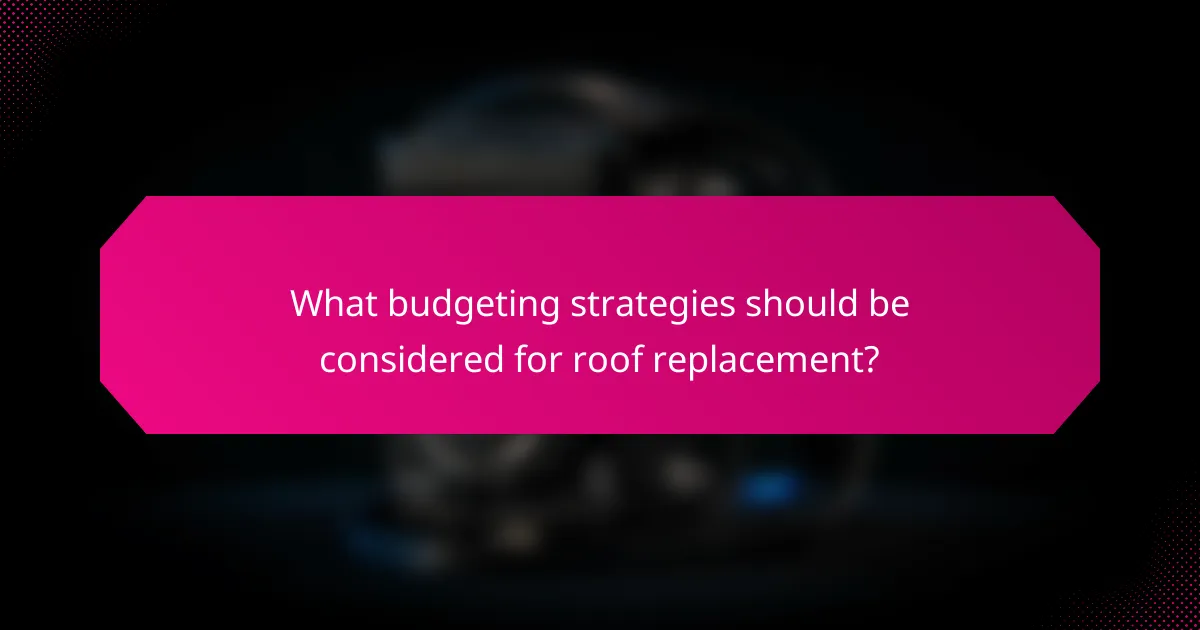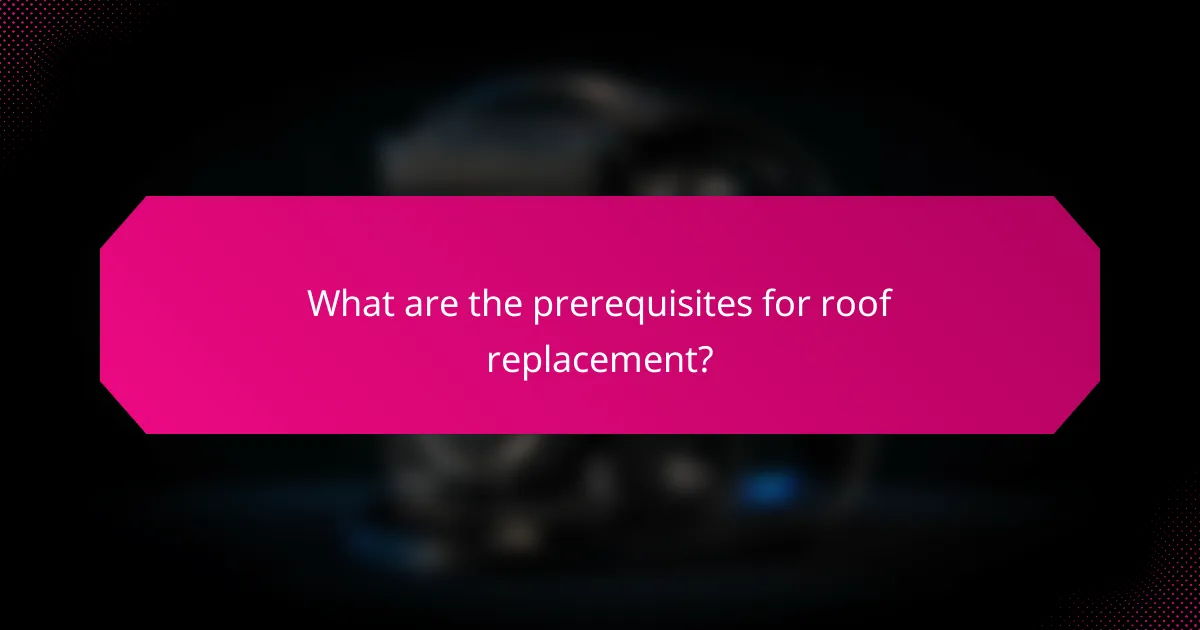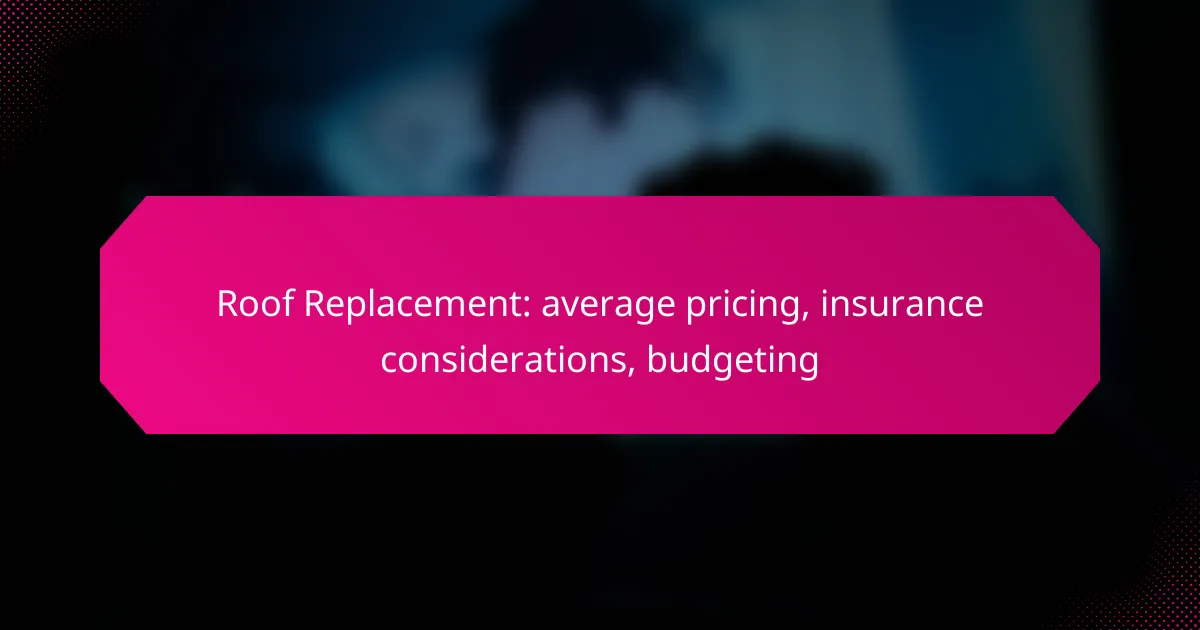Replacing a roof can be a significant investment, with average costs in the UK ranging from £4,000 to £8,000 based on various factors. Homeowners should carefully consider their insurance policies, as coverage can greatly influence out-of-pocket expenses. Additionally, effective budgeting is essential to manage costs and prepare for any unexpected expenses during the project.

What is the average cost of roof replacement in the UK?
The average cost of roof replacement in the UK typically ranges from £4,000 to £8,000, depending on various factors. This price includes materials, labor, and any additional work that may be required to ensure a proper installation.
Average cost range for residential roofs
For most residential properties, the cost of roof replacement can vary significantly based on the size of the roof and the materials used. On average, homeowners can expect to pay between £4,000 and £8,000 for a standard pitched roof. Larger or more complex roofs may push costs higher, sometimes exceeding £10,000.
It is advisable to obtain multiple quotes from reputable contractors to ensure competitive pricing and quality service. Always consider the long-term value of the materials chosen, as cheaper options may require more frequent repairs.
Factors affecting roof replacement pricing
Local labor rates and the time of year can also affect pricing. For instance, roofing projects may be more expensive during peak seasons when demand is high. Always factor in potential delays due to weather or other unforeseen circumstances.
Cost comparison by roofing material
Different roofing materials come with varying costs, which can significantly impact the overall budget for a roof replacement. For example, asphalt shingles are generally the most affordable option, costing around £3,000 to £5,000 for an average-sized roof. In contrast, slate or tile roofs can range from £8,000 to £15,000, depending on the quality and installation complexity.
Metal roofing is another popular choice, typically costing between £6,000 and £12,000. While the initial investment may be higher, metal roofs often offer longer lifespans and lower maintenance costs, making them a cost-effective option over time.

How does insurance impact roof replacement costs?
Insurance can significantly affect the costs associated with roof replacement by determining how much of the expense is covered. Homeowners should understand their policy details to know what is included and how to navigate claims effectively.
Types of coverage for roof replacement
There are generally two main types of coverage for roof replacement: actual cash value (ACV) and replacement cost value (RCV). ACV policies cover the current value of the roof minus depreciation, while RCV policies cover the full cost of replacing the roof without factoring in depreciation.
Homeowners should review their policies to identify which type of coverage they have, as this will directly influence out-of-pocket expenses during the replacement process. Additionally, some policies may include specific endorsements for roof damage due to certain perils, such as storms or fire.
Common insurance exclusions
Many insurance policies have exclusions that can affect roof replacement claims. Common exclusions include damage caused by lack of maintenance, wear and tear, or certain natural disasters not covered by the policy.
Homeowners should be aware of these exclusions to avoid unexpected costs. For example, if a roof is damaged due to neglect or improper installation, the insurance company may deny the claim, leaving the homeowner responsible for the full replacement cost.
Steps to file an insurance claim
Filing an insurance claim for roof replacement typically involves several key steps. First, homeowners should document the damage with photos and notes, then contact their insurance company to report the claim.
After filing, an adjuster will likely visit the property to assess the damage. Homeowners should be prepared to provide any necessary documentation, such as repair estimates or contractor quotes, to support their claim. Following these steps can help ensure a smoother claims process and potentially expedite the approval for funds needed for the roof replacement.

What budgeting strategies should be considered for roof replacement?
Effective budgeting strategies for roof replacement involve assessing costs, planning for unexpected expenses, and exploring financing options. By understanding these elements, homeowners can better manage their finances and ensure a successful roofing project.
Creating a roof replacement budget
To create a roof replacement budget, start by obtaining multiple estimates from reputable contractors. Typical costs can range from several thousand to tens of thousands of dollars, depending on materials and roof size. Include expenses for permits, disposal fees, and potential upgrades to insulation or ventilation.
Break down the budget into categories such as materials, labor, and additional features. This will help you identify areas where you can cut costs or allocate more funds if necessary. Always allow for a contingency of around 10-20% to cover unforeseen expenses.
Emergency funds for unexpected costs
Setting aside emergency funds is crucial for handling unexpected costs during a roof replacement. Issues like hidden damage or structural problems can arise once the old roof is removed. Having a financial cushion can prevent delays and ensure the project stays on track.
Consider establishing a separate savings account specifically for roofing emergencies. Aim to save at least 5-10% of your total budget for these unforeseen circumstances. This proactive approach can alleviate stress and keep your project within budget.
Financing options for roof replacement
Various financing options are available for homeowners needing to replace their roofs. Personal loans, home equity loans, and credit cards are common choices, each with different interest rates and repayment terms. Compare these options to find the best fit for your financial situation.
Additionally, some contractors offer financing plans that allow you to pay over time. Be sure to read the terms carefully, as some may include high-interest rates. Research local grants or assistance programs that may help offset costs, particularly for energy-efficient roofing solutions.

What are the prerequisites for roof replacement?
Before replacing a roof, it’s essential to evaluate the current roof’s condition and understand local regulations. Proper assessment and compliance with permits can prevent costly issues and ensure a smooth replacement process.
Assessing the condition of the existing roof
Start by inspecting the roof for visible damage such as missing shingles, leaks, or sagging areas. A thorough assessment helps determine whether a full replacement is necessary or if repairs can suffice.
Consider hiring a professional inspector to evaluate the roof’s structural integrity and lifespan. This can provide a clearer picture and help you make informed decisions about your roofing options.
Permits and regulations in the UK
In the UK, replacing a roof often requires obtaining planning permission, especially if the property is listed or located in a conservation area. Check with your local council to understand specific requirements.
Additionally, ensure compliance with building regulations, which may cover aspects like insulation and structural safety. Familiarizing yourself with these regulations can help avoid delays and fines during the replacement process.

What are the common types of roofing materials used?
The most common roofing materials include asphalt shingles, metal roofing, and tile roofing. Each type offers distinct advantages and considerations, impacting durability, cost, and aesthetic appeal.
Asphalt shingles
Asphalt shingles are the most widely used roofing material in North America due to their affordability and ease of installation. They typically come in two varieties: organic and fiberglass, with fiberglass being more durable and resistant to moisture.
When considering asphalt shingles, expect to pay between $90 to $100 per square (100 square feet) for materials alone. They generally last around 15 to 30 years, depending on the quality and local climate conditions.
Metal roofing
Metal roofing has gained popularity for its longevity and energy efficiency. Made from materials like steel, aluminum, or copper, metal roofs can last 40 to 70 years and are resistant to extreme weather conditions.
The cost for metal roofing ranges from $300 to $700 per square, making it a more significant investment upfront. However, its durability and potential energy savings can offset the initial expense over time.
Tile roofing
Tile roofing, often made from clay or concrete, is known for its distinctive appearance and exceptional longevity. This type of roofing can last over 50 years and withstand harsh weather, making it a popular choice in warmer climates.
Tile roofs typically cost between $600 to $1,200 per square, reflecting their premium nature. While they are heavier and may require additional structural support, their aesthetic appeal and durability can enhance property value significantly.

What are the long-term benefits of roof replacement?
Roof replacement offers significant long-term benefits, including improved energy efficiency, enhanced property value, and increased safety. A new roof can reduce energy costs and prevent damage from leaks or structural issues.
Average pricing for roof replacement
The average cost of roof replacement varies widely depending on materials, roof size, and labor. Homeowners can expect to pay anywhere from $5,000 to $15,000 in the United States, with asphalt shingles being the most common and affordable option.
Factors influencing pricing include the type of roofing material chosen, the complexity of the roof design, and local labor rates. For example, metal roofs tend to be more expensive upfront but may offer savings in the long run due to their durability.
Insurance considerations for roof replacement
When replacing a roof, it’s crucial to understand how insurance policies may cover the costs. Many homeowners’ insurance policies include coverage for roof damage due to specific events like storms or fire, but coverage for wear and tear may not be included.
Before proceeding with a roof replacement, check with your insurance provider to understand your coverage limits and any deductibles. Documenting the condition of your old roof can also be beneficial when filing a claim.
Budgeting for roof replacement
Budgeting for roof replacement requires careful planning to account for both expected and unexpected costs. Start by obtaining multiple quotes from contractors to get a clear idea of the average pricing in your area.
In addition to the cost of materials and labor, consider setting aside funds for potential repairs or upgrades, such as replacing gutters or improving insulation. A good rule of thumb is to allocate an additional 10-20% of your total budget for unforeseen expenses.
